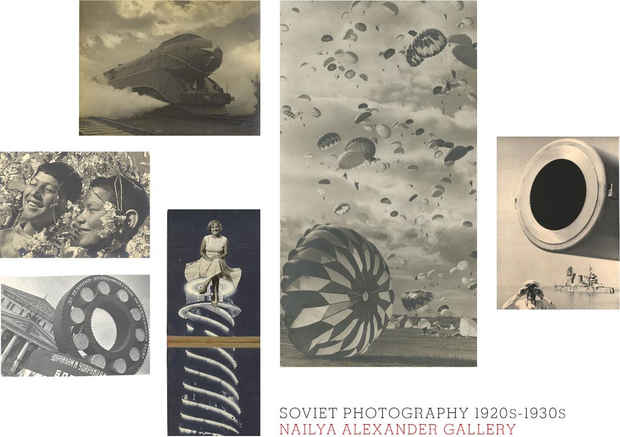“Soviet Photography: 1920s-1930s”
Nailya Alexander Gallery

This event has ended.
Nailya Alexander Gallery presents Soviet Photography: 1920s-1930s.
Nearly a century ago, the 1917 Bolshevik Revolution shook the world, changing the course of history and the fate of photography in Russia. The decades that followed were a time of great experimentation in photography and film, as artists looked forward to a bright proletarian future powered by new media, mass production, and exciting technological advancements. Deviating from straightforward reportage, photographers began to experiment with collage, photomontage, constructivist compositions, and novel stylistic choices like dramatic angles and close-ups and unconventional framing.
Soviet photographers in the 1920s and 1930s created a new mythology, founded on vivid symbols of collective progress, patriotism, and self-sacrifice. Advancements in printing and publishing technologies led to the proliferation of magazines, journals, and posters, and allowed their images to reach vast, largely illiterate swaths of the Russian population, for whom the sight of modern machinery and massive military and athletic formations was an extraordinary revelation. Images like Arkady Shaikhet’s “Komsomol Member at the Wheel” (1929), which features a handsome youth in control of an imposing new machine; the powerful modern engine in “Express” (1939); and the jubilant sky in Emmanuil Evzerikhin’s “Paratroopers” (1939) gave voice to the optimism of the era and a widespread faith in industrial achievements. In this sense, the Soviet photographers of the 1920s and 1930s were true visionaries.
Many pioneers of Soviet photography came from Jewish backgrounds, including Arkady Shaikhet, Semyon Fridlyand, and Max Alpert, the founders of Soviet photojournalism; Georgy Zelma and Max Penson, who documented the transformation of Central Asia; Moisei Nappelbaum, a master of studio portraiture; and Emmanuil Evzerikhin and Yakov Khalip, part of the younger generation that followed in the footsteps of the famous Aleksandr Rodchenko and Boris Ignatovich. This background was inseparable from their careers as photographers in the Soviet Union, particularly after World War II, when many Jewish photographers were forced out of their positions as a result of Stalin’s anti-Semitic campaigns.
Soviet Photography: 1920s-1930s is timed to coincide with The Power of Pictures: Early Soviet Photography, Early Soviet Film, opening September 25 at the Jewish Museum in New York. The Power of Pictures runs through February 7, 2016.
Media
Schedule
from September 09, 2015 to October 30, 2015
Opening Reception on 2015-09-09 from 18:00 to 20:00